The Second World War was a period of remarkable advances in technology and many new weapons were invented during this period, some of which entered production and actually saw service in the war, while others never left the drawing board.
Most of us are familiar with the secret weapons the Nazis had at their disposal in the last months of the war that were expected to turn the tide against the Allies. However, Germany had a reputation as a scientifically advanced nation well before the outbreak of hostilities in 1939. At the beginning of the war, the Germans had a significant advantage in many areas of military technology, although it lost the lead, for a variety of reasons, as the war progressed.
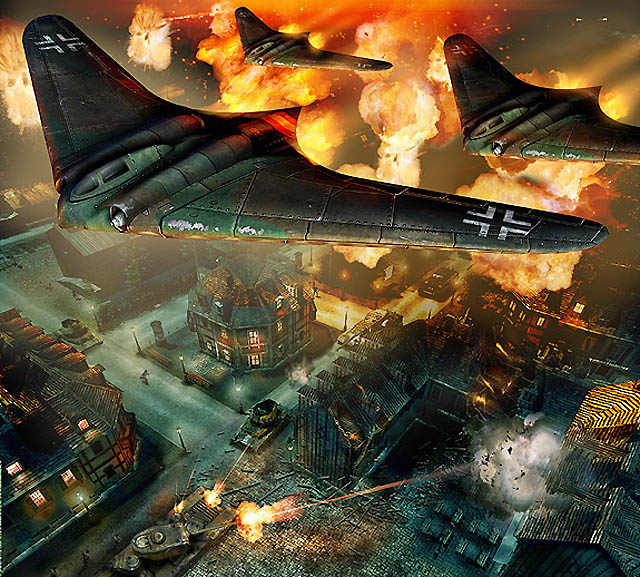
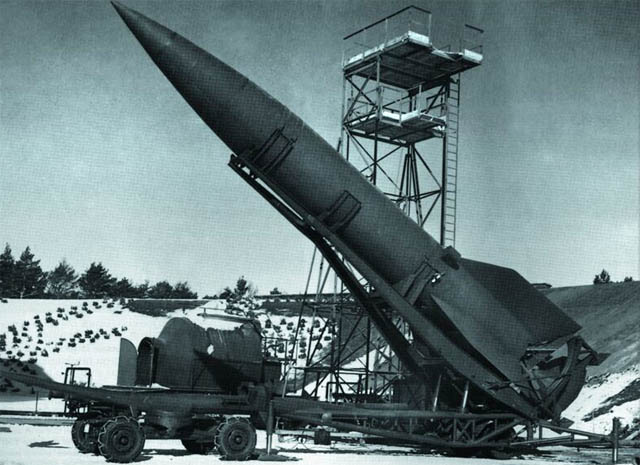
(images via War Front: Turning Point, 1)
For the naval war, Germany built some submarines that could:
- stay submerged for an entire patrol
- used advanced sonar so they could target the enemy without raising the periscope
- were equipped with the first electric powered torpedoes which left no trail of bubbles to give away the sub’s position
- some even had stealth coating, rendering them invisible, when surfaced, to Allied planes using infra-red searchlights.
This was years ahead of its time, similar to the radar absorbing coating of modern stealth aircraft. Germany also developed synthetic fuel from coal, in order to lessen its dependence on imported oil for its petroleum needs. And very early in the war, German bombers operating at night used fixed radio transmitters, with receivers installed in the bombers, to very effectively navigate to their target areas. This system was the forerunner of GPS that we are familiar with today and for the first couple of years of the conflict at least, Allied air forces had no comparable system.
Thinking the war was already won, Hitler placed less emphasis on weapons development. Later, when the war turned against them, Germany turned to new, highly sophisticated weaponry in a desperate bid to turn the tide. These wonder weapons, or wunderwaffe, mostly reached the field of combat too late to make a difference, although some, like the V2 rockets, were deployed and were superior to anything possessed by the Allies at the time. Most of these weapons were very advanced for their era and with the exception of the gigantic tanks, were all developed by other counties in the subsequent decades. There are too many to cover in detail in this article, but here are some of the most fascinating ones.
WunderWaffe 1 - Vampire Vision
The Sturmgewehr 44 was the first ever assault rifle, similar to the modern M-16 and AK-47. The ZG 1229, also known by the code name Vampir, was an infra-red sight designed so that this rifle could be used by snipers at night. It was first used in combat in the last months of the war and weighed about five pounds, but was also connected to a thirty pound battery support pack, strapped to the soldier’s back.
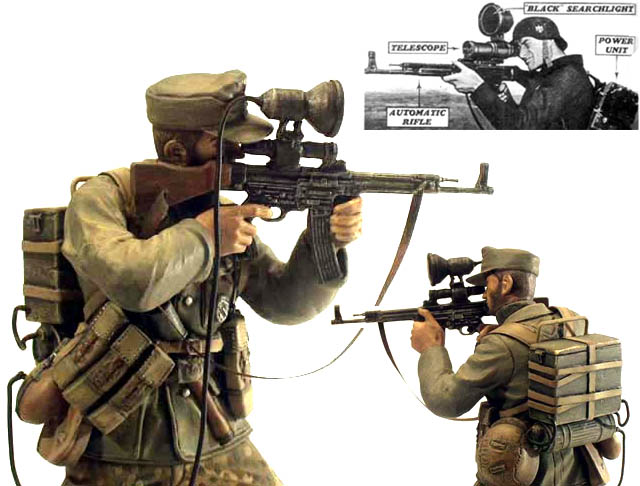
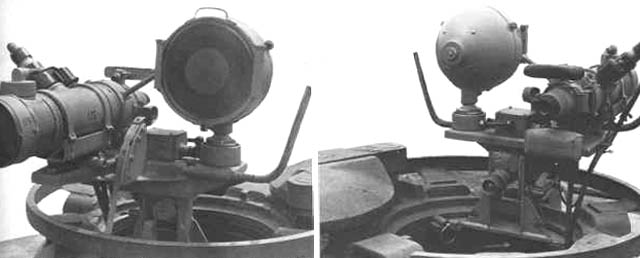
(images via)
WunderWaffe 2 - Shooting Around Corners
"The idea of weapons capable of proving aimed fire from around corners has always existed, and eventually materializes in the form of working pieces. One such device was "Der Gebone Lauf" ("The Curved Barrel"), created by the Germans in WWII, seen below fitted to an MP44 7.92 x 33 mm (7.92 Kurz) caliber assault rifle." (more info)


(images via 1, 2)
WunderWaffe 3 - Super-Heavy Tanks
German engineers worked on a number of designs for super-heavy tanks and the Panzerkampfwagen VIII Maus was the heaviest model of which a working prototype was made during the war. This tank weighed in at around 180 tonnes and this ended up being its principal problem. No engine was powerful enough to allow the tank to achieve the desired speed of 20 km/h, with only 13km/h being reached and that under ideal conditions. It was also too heavy to cross bridges. However, because the tank stood relatively high off the ground, it could actually ford deep streams and for deeper rivers was able to go underwater and drive along the bottom. However, to do this it had to be partnered with another tank, which supplied the electrical power through a cable. Amazingly, a long snorkel, allowing the crossing tank to submerge to a depth of 45 feet, fed air to the submerged tank’s crew.
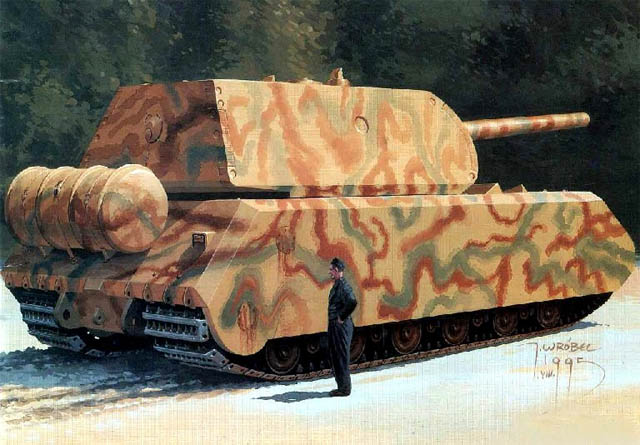

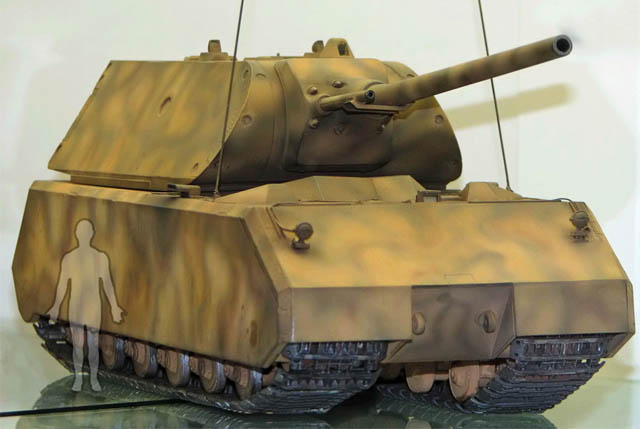
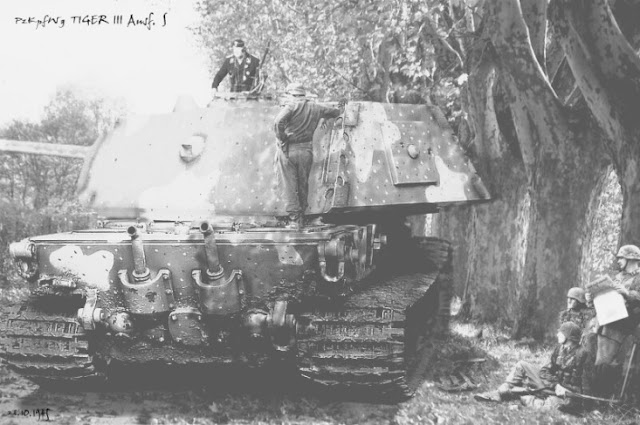
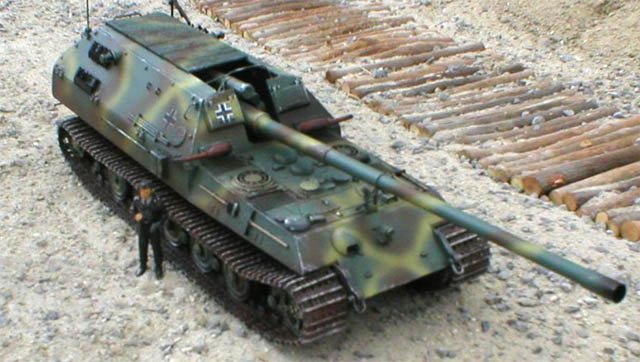
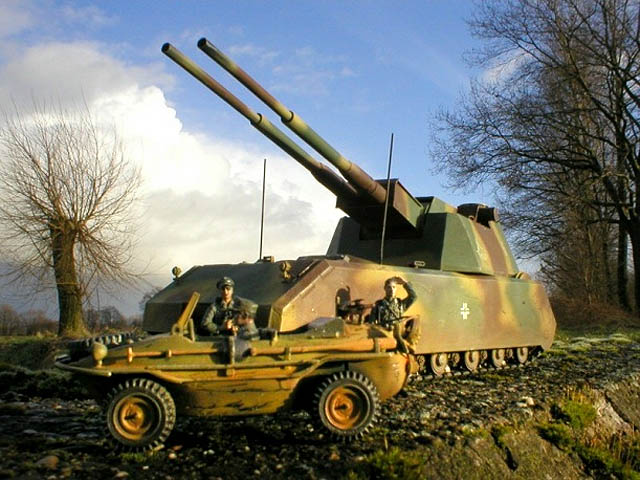

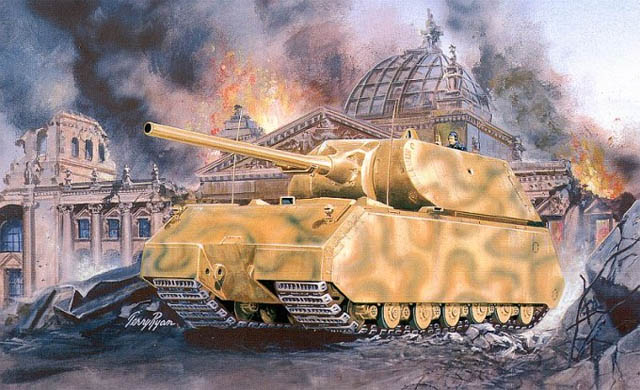
(images via 1, 2, 3, 4, Wydawnictwo «Militaria» Wrobec)
"Design studies found at Krupp showed a version of the Maus carrying a 305mm breech-loading mortar, named 'Bear', and a giant 1500-ton vehicle with a 800mm gun as main armament plus two 150mm guns in auxiliary turrets on the rear quarters. This vehicle, put forward by two engineers named Grote and Hacker, was planned to be powered by four U-boat diesel engines!" (more info)


The Landkreuzer P-1000 Ratte
This image shows how the Tiger tanks grew in size throughout the war:
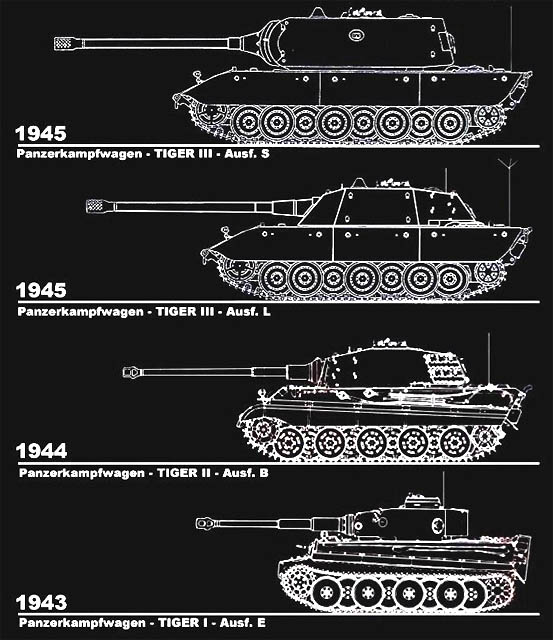
(image via)
WunderWaffe 4 - "The Walking Tank", the mine-clearing vehicle
One of the MinenRaumers - "In 1944, Krupp built a prototype of this super heavy mineclearing vehicle. The 130t vehicle was articulated in the centre, and was suspended on 2.7m diameter steel wheels. These were set on different track widths at front and rear, so as to sweep a wider path. Each section of the Raumer S was powered by a Maybach HL90 motor. It was captured at end of the war by the U.S Army." (source)
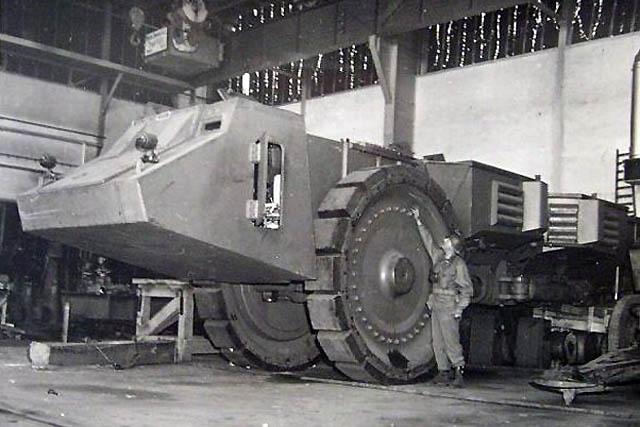


Another design was even stranger, developed by Alkett, Krupp and Mercedes-Benz in 1942:
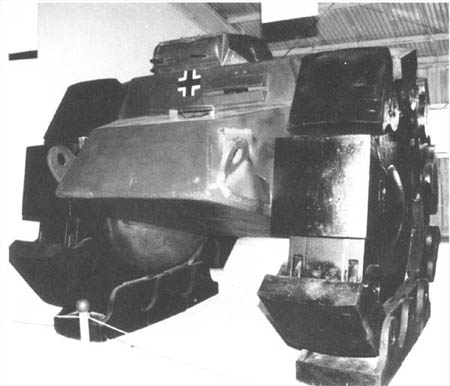

(image via)
"The body of this strange machine built on the mounting of a heavy gun with a cabin including the compartment of combat, the engine compartment and which was surmounted by a turret of Panzer I (2 MG34). The shielding varied from 20 to 40 mm on the body of the machine. The lower part to be able to resist to the mines was of 80 mm. The direction was done using the small wheel located at the back, two larger wheels supplemented the suspension. The steel wheels were provided with steel shoes similar to those used by the German heavy guns at the time of the First World War. The wheels come from Caterpillar trucks. They were in theory to resist the explosive loads of the mines." - via

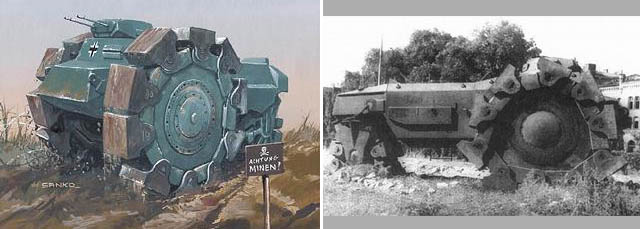
WunderWaffe 5 - the world’s first cruise missile
The Fieseler Fi 103, more familiar as the V-1, from the German vergeltungswaffe or vengeance weapon, was the world’s first cruise missile. The V-1 was powered by jets and carried an 1875 lb warhead with a range of 125 miles, the first ones being launched at England on June 13, 1944, just after D Day. The missile was sometimes delivered in the air from bombers, but was mostly ground launched, with long ramps hidden in wooded terrain. However, these were clearly visible from the air, so were usually bombed very quickly, forcing the German army to use mobile ramps instead, which they moved around the Pas-de-Calais region of the French channel coast.
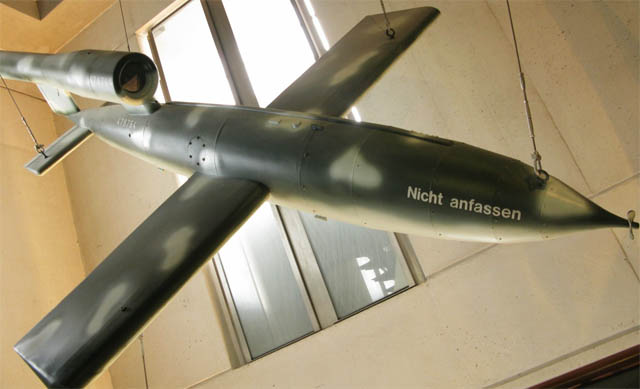
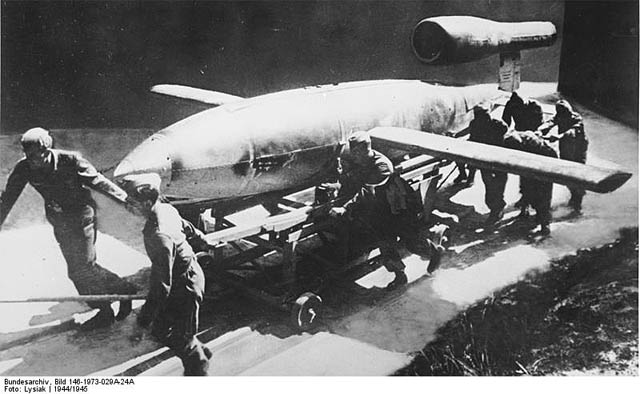
(images via 1, 2)
Recreated launch ramp at the museum in Duxford, UK -
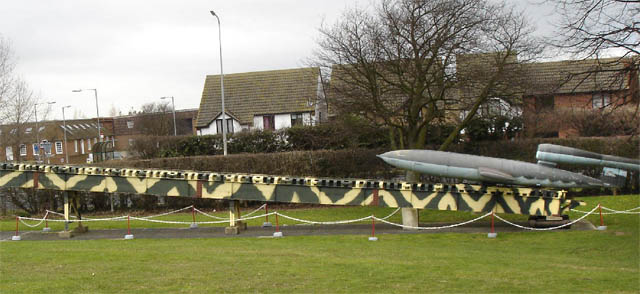
(image via)
Despite its fearsome reputation, although nearly 9,250 V1’s were fired against London and other English towns and cities, fewer than 2,500 reached their target, the others being destroyed by anti-aircraft fire, fighters, and even barrage balloons. However, V1 firing continued, at Antwerp and other cities on the European mainland as well as against England, until Allied forces finally captured the launch areas in late March 1945.
Variation: Rocket-Propelled Piloted Aircraft Bomb - more info:
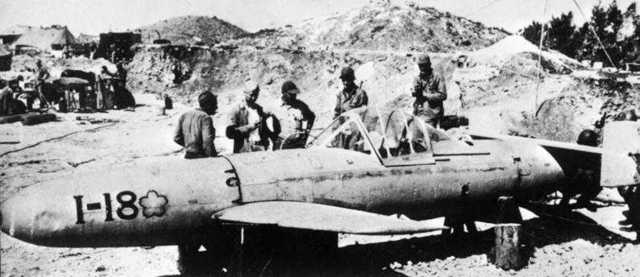

Kamikaze "Ohka" (Cherry Blossom) ordered by Japan empire (U.S.S. "Essex" was hit by one of these, for example)
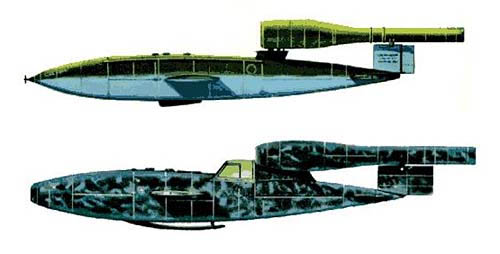
V-1 used against London, and the new V-1 "BAKA", an interesting comparison
WunderWaffe 6 - the original long-range ballistic missile
The V1’s successor, perhaps a little predictably known as the V-2, was the original long-range ballistic missile and the first man-made object to achieve sub-orbital spaceflight. With a range of 200 miles and a 2150lb warhead, the V2 also traveled at 2500 mph, so it was impossible to intercept and hit its target from above faster than the speed of sound. There was no advance warning and although the V2 was far from accurate, it caused mass terror and panic when used against civilians. The rockets were also fired from mobile launchers, which were difficult to locate either before or after they were fired. Over 3000 V2’s were fired against the Allies, killing over 7000 people, both military and civilian, and the rocket threat was only finally ended when the German army was forced to retreat beyond the launch range.
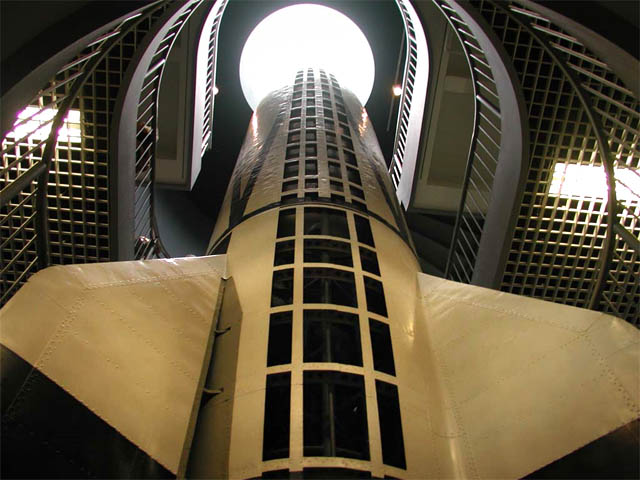


(images via 1, 2, 3, 4)
The V2 was very expensive to produce, inaccurate and only carried a small warhead, but had the Germans had more time to develop it, the war might have taken a very different course. They may have been able to attach a nuclear warhead, and were working on using biological and chemical weapons in the rocket program. By the last days of the war, Germany had supplies of the nerve agents sarin, tabun and soman, but had never used them.
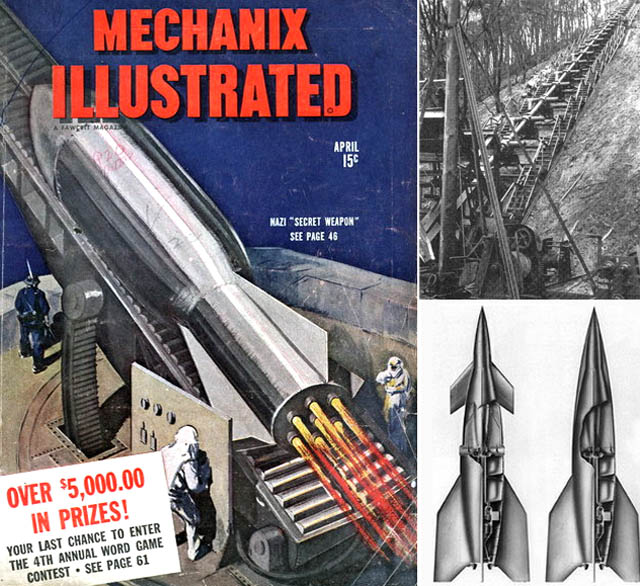
A rocket launching platform towed behind a submarine, intended for use against the North American continent, was successfully tested and scientists were also supposedly at work on the V9 rocket. This version would actually have a pilot, who was to bail out at the last minute with a parachute and be rescued at sea by a submarine. The V9 was to be armed with a one ton warhead, and be able to reach the US from Europe in just thirty five minutes.
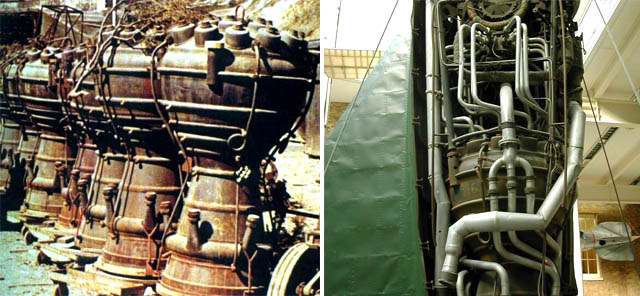
Rusting V2 engines, images via 1, 2, 3
At the end of the war, American, British or Soviet forces captured many German weapons, undeveloped projects and blueprints, plus the scientists who worked on them. Rocket scientists in particular played a large role in the space race and were instrumental helping the United States achieve the moon landing in 1969.
WunderWaffe 7 - the rocket-powered fighter plane
With aircraft, some of the German designs not only made it off the drawing board, but also flew in combat, although often not in sufficient numbers to alter the course of the war in Germany’s favour. The Messerschmitt Me 163 was the only operational rocket-powered fighter plane of the war, but although it was very advanced it performed poorly in combat and downed limited numbers of Allied aircraft.
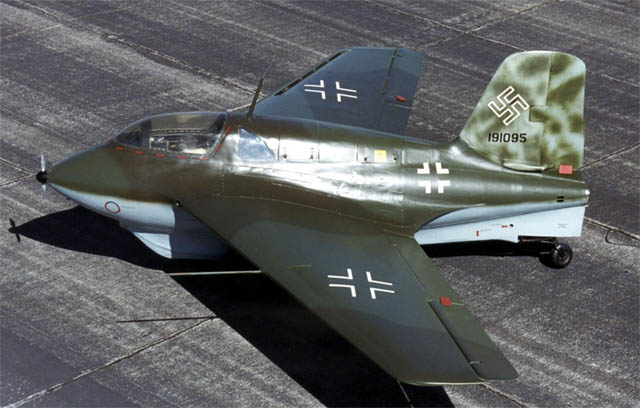
(image via)
The first turbojet fighter aircraft, the Messerschmitt Me 262, first appeared in the skies over Europe in 1944. Although arriving too late to seriously impact the course of the conflict, the Me 262 still claimed over 500 Allied aircraft, losing around 100 Me 262s in the process.
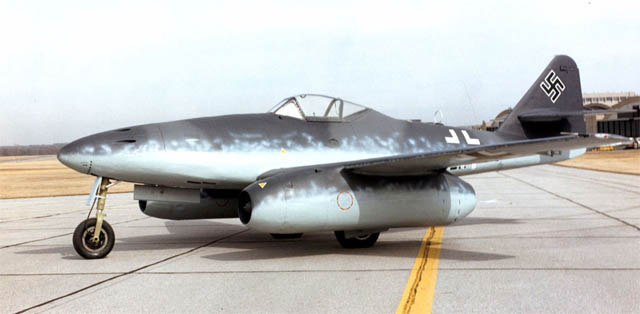
(image via)
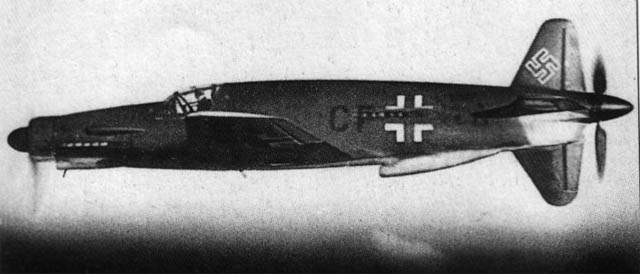
Strange prototype Dornier Do-335, with propellers both in front and in back
Intended to be the successor of the Me 262, the Focke-Wulf Ta-183 fighter jet had only been tested in wind tunnels by the end of the war, although the plane’s basic design was developed in Argentina after 1945. Is thought that the Soviet MiG-15 was based on captured German plans, and the two planes do bear some resemblance, although Russian historians reject these theories.
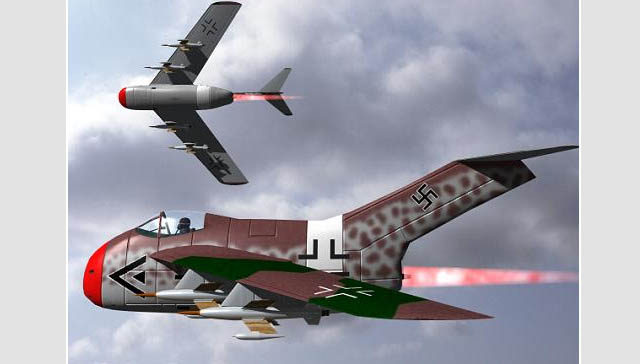
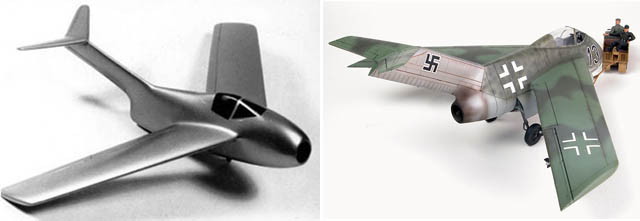
images via 1, 2, 3
The Bachem Ba 349 was an experimental rocket-powered interceptor. With a vertical take off rather than using vulnerable airfields, it was intended to operate like an unmanned missile. Most of its journey to reach enemy bombers was radio controlled by ground personnel, although it did have a pilot, who would aim at the target and fire its rockets when close enough. However, the test pilot was killed in the plane’s first and last test flight in March 1945 - more info.
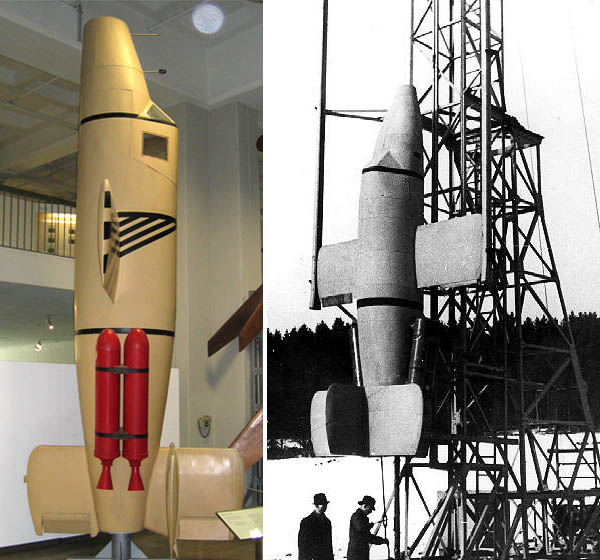
(images via 1, 2)
The DFS 346 was a high-speed, rocket powered research aircraft. The prototype, unfinished at the time of the German surrender, was apparently rebuilt and underwent successful test flights in the Soviet Union a few years later - more info

The Heinkel He 162 was a single engine jet fighter. It was made mostly of wood, since by this stage of the war, metals for aircraft manufacture were becoming scarce, but the He 162 was the fastest of the early jets. Henschel’s Hs 132, an interceptor aircraft and dive-bomber, never flew in active combat:

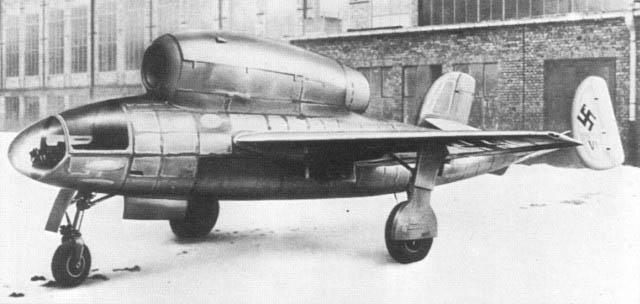
Heinkel He 162 above, Henschel’s Hs 132 below. images via
The Arado 234, the world’s original jet bomber, was very advanced for its time. It was equipped with automatic pilot, an ejector seat, pilot-aimed rear guns, and powered by twin jet engines, it proved far too fast for Allied planes to intercept.

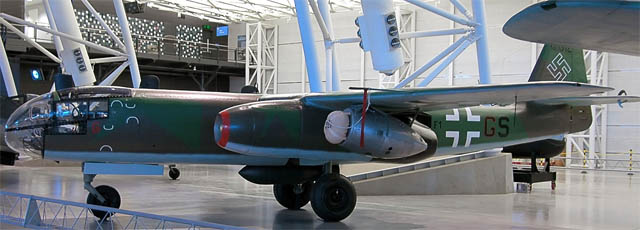
WunderWaffe 8 - a sub-orbital bomber
Silbervogel, which translates as Silverbird, was a rocket powered sub-orbital bomber, which was tested in wind tunnels, but never actually produced. However, it was a forerunner of future winged space vehicles such as the Space Shuttle.
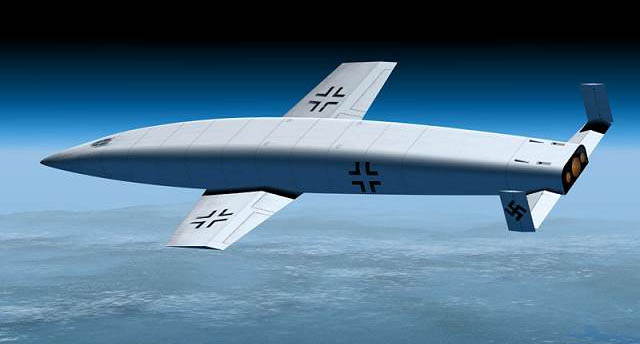
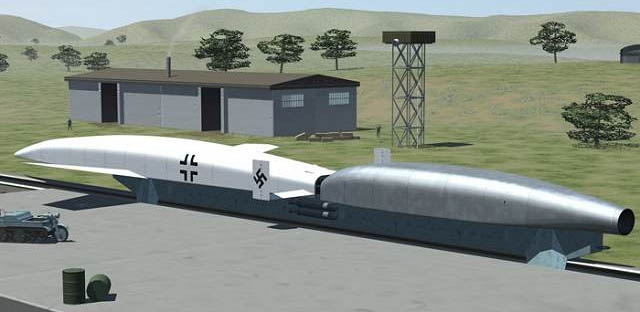
(images via)
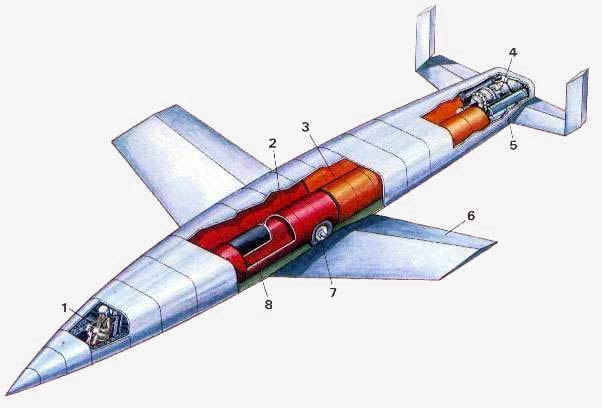
1) Pressurized Cockpit 2) Oxidant Tanks 3) Fuel Tanks 4) High-Pressure Combustion Chamber of 100 Tons Thrust 5) Auxiliary Rocket Chambers 6) Wedge-Shaped Wing 7) Retracted Undercarriage 8) Free-Falling Bomb - image via
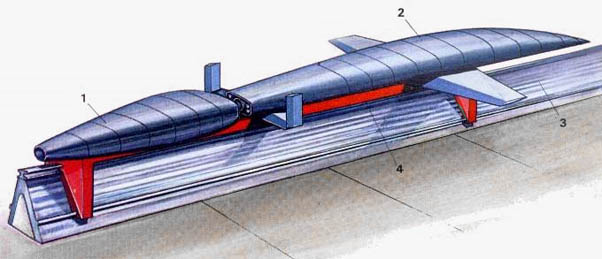
1) Captive Rocket Booster of 600 Tons Thrust 2) Sänger Amerika Bomber of 100 Tons Thrust 3) 3 Km (1.9 miles) Long Monorail Track 4) Sled Carriage - image via
Scientists believed that the Silbervogel would be able to cross the Atlantic carrying an 8,800 lb bomb to the continental USA, and then land in territory held by Japan in the Pacific. It would cover such a vast distance in a series of hops. After reaching 1200 mph with the help of a rocket-powered sled on a two mile rail track, the Silverbird’s rocket engines kicked in once it was airborne. Eventually flying at ninety miles and at a speed of almost 14,000 mph, it would slowly fall into the stratosphere and greater air density would give it a bounce to regain altitude. The size of the bounce would decrease each time, but German technicians still figured the Silverbird was very capable of making a mind-boggling trip of between 12000 and15000 miles.
WunderWaffe 9 - the flying-wing bomber
The Horten Ho-IX was a flying wing fighter/bomber, the prototype being developed in the latter part of the war. We show both "Gotha" and "Horten" projects here:

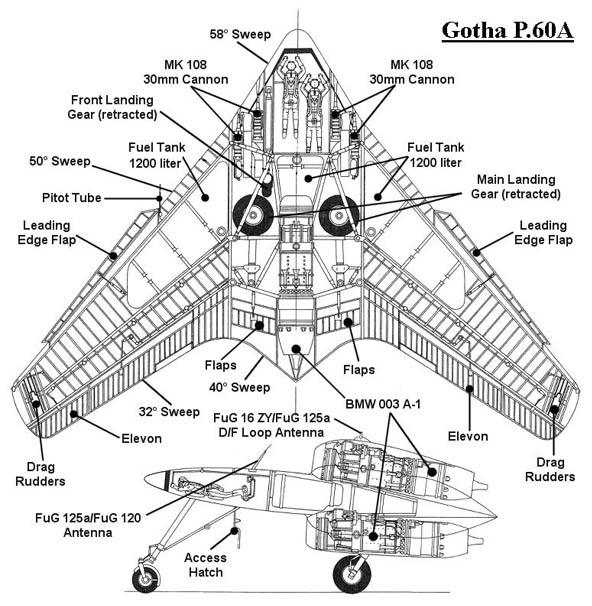
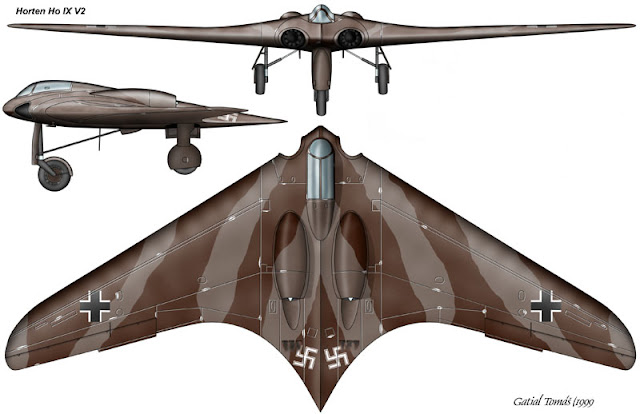
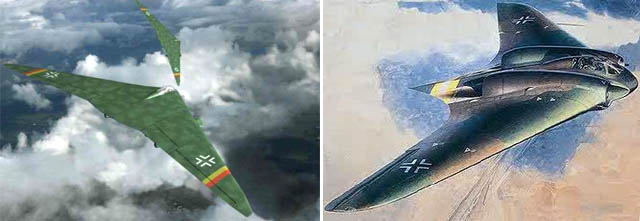
(image courtesy Jozef Gatial Thomas, see more here)
The earliest military helicopters were built by Germany and mainly saw service in the Mediterranean, but a few were also used in the Aegean and Baltic theatres. Both the Flettner 282 and the Focke Achgelis 223 (shown here) were never built in large numbers as a result of the production facilities being destroyed by Allied bombers.
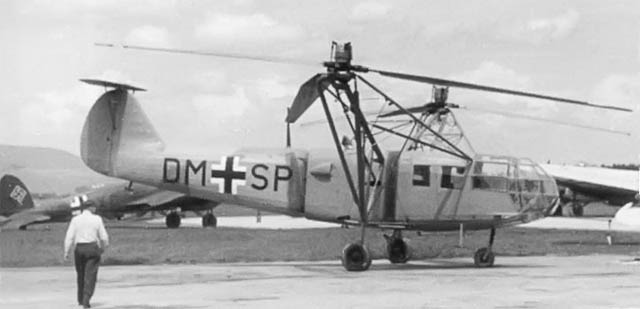
(image via)
WunderWaffe 10 - the Wind Cannon & the Vortex Gun
Some of the more bizarre inventions and ideas developed by German scientists were
- the sun cannon
- the vortex gun
- the sound cannon
- and the wind cannon.
The sun cannon had a big sun-reflector intended for use against enemy aircraft. The Americans captured an experimental model of the cannon in 1945, but its unknown whether any tests were done after the war - more info
The vortex gun was designed to try and take advantage of the known fact that air turbulence could bring down large aircraft and break them into pieces. The vortex gun’s shells, containing coal-dust and a slow-burning explosive in the center, were supposed to create an artificial whirlwind or tornado, which would make enemy airplanes lose control and thus fall from the sky. During testing and under near perfect conditions this odd device seemed to work quite well. It wasn’t known if the air pressure would actually cause structural failure in a plane, but the pressure it put on the wings would probably be very high and that might be enough to down the aircraft. Fortunately for the Allies, the vortex gun was never put into practice.
The wind cannon was designed to shoot a powerful jet of compressed air, as effective as a small shell, against enemy aircraft. As you can see from this picture it was an odd looking device. In tests, such a blast could break a 25mm wooden board from over 600 feet away. However, the potential effect on a fast moving aircraft would obviously be very different than against a fixed target, so as intriguing as the wind cannon was, it was unlikely to have produced the desired results. Even so, a cannon was set up on at one on the Elbe bridges in the closing stages of the war, but didn’t succeed in bringing down any hostile planes.
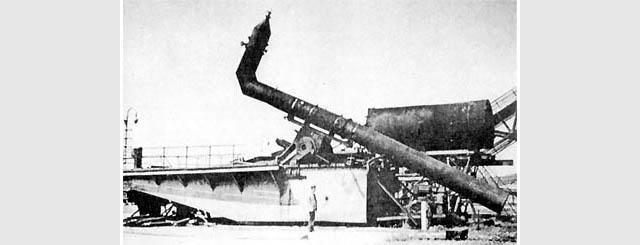
(image via)
The sound cannon was supposed to turn explosions of oxygen and methane into noise that could kill. A very high amplitude sound beam would be emitted at pressures exceeding 1000 milibars from a distance of around 150 feet, which would be fatal to a human exposed to it for thirty seconds. At a greater distance, a soldier would still suffer great pain and be seriously incapacitated for a considerable time afterwards. The sound weapon wasn’t used in combat or tested on people but it is thought that lab animals may have been used. Another acoustic device, which was said to resemble a large cannon, supposedly sent out a sonic boom shock wave with enough force to bring down a large bomber.
All of these "wonder weapons" are confirmed fact; if you'd like to chek out various myths (including Nazi UFO Flying Saucer program), then there are plenty of sites to help you along. In our future articles we will touch on fantastic "secret" weapons of the Communist block and, pehaps, some spy technology.

(image via)